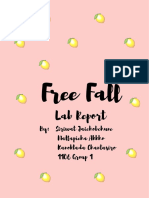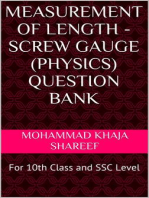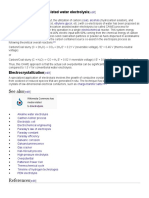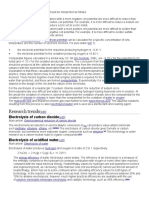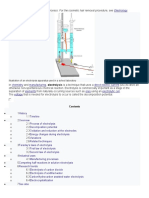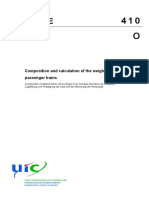Applied Maths I.A Unit 2 Friction: Presentation College, San Fernando Darien Wong
Applied Maths I.A Unit 2 Friction: Presentation College, San Fernando Darien Wong
Uploaded by
waseem555Copyright:
Available Formats
Applied Maths I.A Unit 2 Friction: Presentation College, San Fernando Darien Wong
Applied Maths I.A Unit 2 Friction: Presentation College, San Fernando Darien Wong
Uploaded by
waseem555Original Description:
Original Title
Copyright
Available Formats
Share this document
Did you find this document useful?
Is this content inappropriate?
Copyright:
Available Formats
Applied Maths I.A Unit 2 Friction: Presentation College, San Fernando Darien Wong
Applied Maths I.A Unit 2 Friction: Presentation College, San Fernando Darien Wong
Uploaded by
waseem555Copyright:
Available Formats
APPLIED MATHS I.
A UNIT 2 Friction
Presentation College, San Fernando Darien Wong
Centre Number: 160042 CANDIDATE NUMBER: TEACHER:MR. Akaloo FORM: 61S1
Darien Wong
Friction
Contents
Statement of Task ................................................................................................................................ 3 Aim : .................................................................................................................................................. 3 Definition of the Variables ............................................................................................................... 3 Description of Plan ........................................................................................................................... 4 Data collected..................................................................................................................................... 5 Activity Table .................................................................................................................................. 5 Design of Experiment ................................................................................................................... 6 Analysis ............................................................................................................................................... 8 Results from the Experiment .................................................................................................... 12 Calculations ........................................................................................................................................ 13 Evaluation ......................................................................................................................................... 18 Assumptions ..................................................................................................................................... 19 Sources of Error .................................................................................................................................. 19 Conclusion ........................................................................................................................................ 20 Bibliography..................................................................................................................................... 21
2|Page
Darien Wong
Friction
Statement of Task
Aim :
The aim of this experiment is to determine if the coefficient of friction, is independent of the area of contact of two rough surfaces which are in relative motion. This analysis also seeks to obtain the minimum completion time for this investigation. The experiment will involve the movement of a wooden cuboid across a horizontal table. The movement will be driven by a pulley system in which the cuboid is connected to a mass (particle). The minimum completion time was found by obtaining the critical path for major tasks which were carried out to make this experiment feasible.
Definition of the Variables
Controlled Variables: Mass of wooden cuboid, Mass of the particle Distance, x, moved by particle. Length of light, inextensible string used for pulley
Manipulated Variable: Area of contact for the two surfaces in relative motion (faces of the cuboid).
Responding Variable: Time taken for particle to move distance, x.
3|Page
Darien Wong
Friction
Description of Plan
The critical path analysis will be made feasible using accurate estimations of the time it would take to carry out each event. The estimations will be obtained from a previously done experiment in which similar tasks were carried out. Each event will be coded with a letter and utilizing an algorithm the activity on node diagram will be created. After which the float times are to be calculated and the critical path found. From the experiment, the distance, from the point of release of the particle to being incident on the floor will be recorded. The time taken, t for the particle to move through the distance, will also be recorded. An average value for the time taken will be calculated. Equations modeling the system of connected particles will then be created. The equations will conform to Newtons 2nd law of motion. The acceleration of the bodies will be calculated using the equation of motion for constant acceleration. The coefficient of friction will then be calculated using the friction formula. The experiment will then be repeated using different areas of contact. This will be achieved by alternating the faces of the cuboid which are in contact with the table top.
4|Page
Darien Wong
Friction
Data collected Activity Table
The following table lists the activities involved in the project along with the estimated time each activity takes. The estimated times were obtained from a previously done experiment with similar tasks. The table will assist in creating an activity network to determine the critical path and thus be used to maximize efficiency.
Activity Name
A B C
Activity
Design and Model experiment Gather Equipment Measure Dimensions of Cuboid and label faces M ,N and O Obtain the mass of the wooden cuboid using an electronic balance Measure distance, from table top to floor Attach pulley to cuboid and have it locked in place. Attach particle to the other end of the pulley and allow it to hang at the edge of the table top Set up Video camera to observe the motion of the particle Conduct the experiment
Preceding Activities
A B
Time (minutes)
20 15 5
E F
B B
3 5
15
I J
C,F,G,H
60 10
Find and record values I for and Table 1: showing the activities and the estimated times for each activity
5|Page
Darien Wong
Friction
Design of Experiment
Apparatus: Measuring Tape, electronic balance, rough wooden cuboid, particle of known mass, smooth pulley, light inextensible string, rough horizontal table.
Diagram:
Light, inextensible string
Smooth pulley
////////////////////////////////////////////////////////////// // Rough Table top Wooden cuboid
Particle
Floor
Figure 1: showing set up of apparatus
Video Camera
6|Page
Darien Wong
Friction
Method:
The contact area was calculated by measuring the dimensions of the cuboid which would be in contact with the rough table top. This was done via the measuring tape. The mass of the cuboid was recorded using the electronic balance. The apparatus was then set up as shown in Figure 1 on page 5. The cuboid was locked in place on the rough horizontal table and the light inextensible string was attached to it. The string was then passed over the smooth pulley and connected to the particle of mass, 0.5kg. It was then ensured that the particle was allowed to hang freely and that the string between the pulley and the cuboid was parallel to the table top. The distance of the particle to the floor was then measured using the measuring tape. It was also ensured that the length of the string between the pulley and the cuboid was sufficient such that the cuboid was unable to fall off the table top. The video camera was turned on and recording began. The cuboid was unlocked removing the system from equilibrium and the particle plunged to the floor. The time taken for this to occur was found accurately from the video camera. This was repeated to obtain 3 set of values for time, t to which an average, tavg was calculated. The experiment was then repeated using the second and third face of the cuboid which possessed a different surface area. The experiment was then repeated 4 more times to obtain accurate values.
7|Page
Darien Wong
Friction
Analysis
The following algorithm was used to model the order of events during this experiment and thus assist in determining the critical path. START: Write down the original vertices and then a second copy of them alongside. If activity Y must follow activity X. Draw an arc from original vertex Y to shadow vertex X. (In this way you construct a bipartite graph) STEP1: Make a list of all the original vertices which have no arcs incident on them. STEP2: Delete all the vertices found in step 1 and their corresponding shadow vertices and all arcs incident to these vertices. STEP3: Repeat steps 1 and 3 until all vertices have been used.
Activity Name
Preceding Activities
A B A C B D B E B F B G B H B I C,F,G,H J I Table 3: showing activities and their precedence restrictions.
8|Page
Darien Wong
Friction
The following was done via the algorithm; A B C D E F G H I J A B C D E F G H I i J B C D E F G H i I J A B C D E F G H I J
B C D E F G H I J C D E F G H I J
C,D,E,F,G,H I I J J
9|Page
The following is the activity network for the major tasks undertaken in the investigation. The activity on node technique was used to represent the network. The graph indicates the duration, earliest start time and latest start time for activities. START 0 0
A 0
20 0
B 20
15 20
E 35
3 47
H 35
15 35
35 45
35 43
35 45
35 45
I 50
60 50
J 110
10 110
FINISH 120 120
Darien Wong Key Activity
Friction
Time taken Latest start time
Earliest start time
Activity A B C D E F G H I J
Time taken (minutes) 20 15 5 7 3 5 5 15 60 10
Earliest Start Time (minutes) 0 20 35 35 35 35 35 35 50 110
Latest Start Time (minutes) 0 20 45 43 47 45 45 35 50 110
Float Time = Latest start time Earliest start time(minutes) 0 0 10 8 12 10 10 0 0 0
Table 4: showing the float times of each activity
The Critical path was found to be; A B H I J
The Forward passes and backward passes were calculated giving the earliest and latest start times for each event respectively. The activities with float times of zero were said to be critical to the efficient completion of the experiment. With these activities started and completed on time the experiment was estimated to take a total time of 120 minutes.
11 | P a g e
Darien Wong
Friction
Results from the Experiment
The table below shows the results recorded from the experiment
Contact Area (m2) Exp1
Exp2
Time taken for particle to hit the floor (s) t1 2.2 2.0 2.5
2.2 2.4 2.1
t2 2.3 2.1 2.4
2.4 2.1 2.2
T3 2.1 2.3 2.1
2.1 2.3 2.1
0.50 0.75 1.0
0.50 0.75 1.0 0.50 0.75 1.0 0.50 0.75 1.0 0.50 0.75 1.0
tavg = 2.2 2.1 2.3
2.2 2.3 2.1 2.2 2.1 2.3 2.2 2.3 2.1 2.2 2.1 2.3
Exp3
2.1 2.3 2.1
2.1 2.3 2.1
2.2 2.0 2.5
2.2 2.4 2.1
2.3 2.1 2.4
2.4 2.1 2.2
Exp4
Exp5
2.1 2.3 2.1
2.3 2.1 2.4
2.2 2.0 2.5
Table 2: Showing Results From the Experiment
12 | P a g e
Darien Wong
Friction
Calculations
Let; mA : mass of the cuboid mB: mass of the particle T: tension in the string R: Normal reaction force between the table top and cuboid FR: Sliding Frictional Force : coefficient of friction for the two surfaces in contact : distance from particle to floor g: acceleration due to gravity taken as 9.81 ms-2 Nota Bene: Downwards is taken as positive that is the direction the particle falls.
Figure 2: showing the forces acting on the system
Light, inextensible string FR T Smooth pulley
T ///////////////////////////////////////////////////////////////// / Rough Table top mAg Wooden cuboid mBg
Particle
Floor
Video Camera
13 | P a g e
Darien Wong
Friction
NEWTONS 2nd LAW
Newtons 2nd law states that the rate of change of momentum of a body is directly proportional to the external force acting on the body and takes place in the direction of the force. The resulting equation is F=ma .
Applying Newtons 2nd w.r.t. the cuboid T FR = mAa .(i)
Applying Newtons 2nd Law w.r.t the particle mBg T = mBa ............................(ii) (i)+(ii) mBg FR = mAa + mBa FR = mBg a(mA + mB).(iii)
Sliding frictional force, FR= R
Consider the cuboid. During its motion there is no vertical movement hence the resultant of the forces in the vertical plane is zero R=mAg FR = mAg
Substituting FR = mAg in equation (iii) mAg = mBg a(mA + mB)
.(iv)
14 | P a g e
Darien Wong
Friction
Recall: Equation of motion for constant acceleration (In accordance with Newtons 2nd law of motion the acceleration acts in the direction of the resultant force) Initally, the particle is at rest Hence,
Substituting
in equation (iv)
For Expirment:
mA = 1 kg mB = 0.5 kg = 1.5m
15 | P a g e
Darien Wong
Friction
Coefficient of friction,
Contact Area(m2) 0.5 Exp1 0.75 1.0 Exp2 0.5 0.75 1.0 0.5 0.75 1.0 0.5 0.75 1.0 0.5 0.75 1.0
Average time taken, tavg 2.2 2.1 2.3 2.2 2.3 2.1 2.2 2.1 2.3 2.2 2.3 2.1 2.2 2.1 2.3 Table 5: summary of results
0.41 0.40 0.41 0.41 0.41 0.40 0.41 0.40 0.41 0.41 0.41 0.40 0.41 0.40 0.41
Exp3
Exp4
Exp5
For Exp1:
= =
= 0.406
0.41 (to 2 sig. fig.)
For Exp2:
= =
= 0.406
0.41 (to 2 sig. fig.) 16 | P a g e
Darien Wong For Exp3:
Friction
= =
= 0.406
0.41 (to 2 sig. fig.) For Exp4:
= =
= 0.406
0.41 (to 2 sig. fig.) For Exp5:
= =
= 0.406
0.41 (to 2 sig. fig.)
average coefficient of friction :
=0.41
17 | P a g e
Darien Wong
Friction
Evaluation
In order to obtain the critical path, graph theory and the previously stated algorithm were utilized. The critical path was found to be A B H I J
This corresponds to the activities A: Design and model experiment, B: Gather equipment, H: Set up video camera to observe the motion of the particle, I: Conduct the experiment J: Find and record values for and
This indicates the activities which must be started on time to ensure that the experiment was completed in the minimum time. Any delays in the commencing or termination of these activities would have resulted in experiment taking longer to complete. The experiment was calculated to have duration 120 minutes as long as the critical path was used with no delays.
When the surface of a body moves or tends to moves over that of another, each body experiences a frictional force. The frictional forces act along a common surface, and each is in such a direction as to oppose the relative motion of the surfaces. The frictional force which exists between two adjacent surfaces which are in relative motion is called the sliding (or dynamic or kinetic) frictional force. There are three laws of friction which are as follows: 1. The frictional force between two surfaces opposes their relative or attempted motion 2. Frictional forces are independent of the area of contact of the surfaces 3. For two surfaces which have no relative motion the limiting frictional force is directly proportional to the normal reaction. This experiment seeks to verify the second law of friction that is the frictional force generated is independent of the contact area of the surfaces. The coefficient of friction, usually lies in the region {0 < < 1} and is dependent on the materials in contact. Therefore for this investigation the
coefficient of friction is specific to the two surfaces in relative motion that is the cuboid and tabletop. The experiment found that for the three different contact areas the coefficient of friction was approximately the same and had an average value of 0.41. This is as expected since the equation determining the frictional force is independent of contact area and dependent only on the coefficient of friction and the normal reaction the body has with the surface. The coefficient of friction of wood on wood surfaces usually ranges from 0.25 to 0.50 for dry surfaces. Hence, the value calculated for the coefficient of friction corresponds with previously done experiments as the cuboid and table top were both wood.
18 | P a g e
Darien Wong
Friction
Assumptions
The following assumptions were made when modeling the system investigated; 1. The body of mass, mB was assumed to be a particle; therefore drag forces on the body were neglected. The body of mass, mB could have experienced a drag force due to air resistance, resulting in a lower acceleration on the body than calculated. 2. The string was considered to be light and inextensible. Therefore, calculations did not account for the effect the weight and extension of the string would have had on the acceleration of the connected bodies. Also, the string would have exerted a force on the pulley. 3. The pulley was considered smooth. Thus, its coefficient of friction was zero. If a force was experienced here (that is the pulley was not smooth) it would have changed the system as a new force would have been introduced to the system. 4. Other resistive forces on the cuboid (air resistance) were considered to be negligible and were ignored. Nevertheless they may have affected the acceleration of the connected bodies.
Sources of Error
The human reaction time would have created some inconsistencies in readings therefore an average was taken to reduce this random error and increase the precision of the results.
19 | P a g e
Darien Wong
Friction
Conclusion
The critical path for the experiment was found to be;
It was also calculated that the experiment had a completion time of 120 minutes
The coefficient of friction was found to be independent of the contact area as expected, also the coefficient of friction between the cuboids (wood) and the tabletop (wood) was found to be; 0.41(to 2 sig fig)
20 | P a g e
Darien Wong
Friction
Bibliography
Bostock, L., & Chandler, S. (1984). Mathematics-Mechanics and Probability. Cheltenham: Stanley Thornes Ltd. Muncaster, R. (1993). A-Level Physics Fourth Edition. United Kingdom: Nelson Thornes Ltd.
21 | P a g e
You might also like
- Manual de Servicio Aire Acondicionado LGDocument66 pagesManual de Servicio Aire Acondicionado LGJorge Albiol100% (1)
- Simple PendulumDocument5 pagesSimple PendulumKen RubioNo ratings yet
- Free Fall Lab ReportDocument12 pagesFree Fall Lab Reportapi-29541704150% (2)
- Lab 1Document3 pagesLab 1HimatushNo ratings yet
- Lab 1Document6 pagesLab 1Anonymous KoWDF8cuvNo ratings yet
- Coefficient of Kinetic Friction and Drag ForceDocument7 pagesCoefficient of Kinetic Friction and Drag ForcejhhjjhNo ratings yet
- Physics 4A: Experiment 2: The Acceleration Due To GravityDocument7 pagesPhysics 4A: Experiment 2: The Acceleration Due To GravityMaha sidNo ratings yet
- Experiment 3 PhysicsDocument15 pagesExperiment 3 Physicsmuhammad asimNo ratings yet
- Lab 5Document6 pagesLab 5patelNo ratings yet
- Wa0006.Document67 pagesWa0006.876 GameheadNo ratings yet
- Mechanics Lab ExperimentsDocument56 pagesMechanics Lab ExperimentsAnonymous AOJRl09aNo ratings yet
- Experiment 2 - The Relationship Between Force and AccelerationDocument12 pagesExperiment 2 - The Relationship Between Force and Accelerationmuhammad asimNo ratings yet
- Lab Manual - Physics.soeDocument20 pagesLab Manual - Physics.soejhoyvanNo ratings yet
- Lab - ManualDocument25 pagesLab - Manualaleksa grailNo ratings yet
- (Eng) Unit 3 - Reni Ruanti (1412440004)Document47 pages(Eng) Unit 3 - Reni Ruanti (1412440004)aekimNo ratings yet
- Accelerated Motion Between Holding Magnet and Light BarrierDocument26 pagesAccelerated Motion Between Holding Magnet and Light BarrierLA LazarohNo ratings yet
- Chapter 1 MaterialsDocument31 pagesChapter 1 MaterialsFahmi AmiNo ratings yet
- Exploring Acceleration Activity 4Document10 pagesExploring Acceleration Activity 4Nadiah LamriNo ratings yet
- Ce 402 Expt 7-8Document16 pagesCe 402 Expt 7-8veeveegarcia_No ratings yet
- Applying Newton's Laws Lab: Forces and Dynamics in 2D: Part 1: On TargetDocument10 pagesApplying Newton's Laws Lab: Forces and Dynamics in 2D: Part 1: On Targetapi-357499261No ratings yet
- SANTOS Activity1-3BDocument21 pagesSANTOS Activity1-3BGabriel SantosNo ratings yet
- Physics 133 Experiment No. 3 AccelerationDocument3 pagesPhysics 133 Experiment No. 3 AccelerationGiovanniDaltonNo ratings yet
- Collaborative Work Physics 1Document16 pagesCollaborative Work Physics 1ScribdTranslationsNo ratings yet
- 6B Lab Manual 2015Document18 pages6B Lab Manual 2015Tj RobertsNo ratings yet
- Lab 3: Projectile MotionDocument12 pagesLab 3: Projectile MotionUdara Silva100% (1)
- Activity 7 Energy Transformation (2021)Document5 pagesActivity 7 Energy Transformation (2021)Pamela LomagdongNo ratings yet
- AnalysisDocument8 pagesAnalysisCatherine N. CapalosNo ratings yet
- IIT Physics Lab Manual (Combined)Document34 pagesIIT Physics Lab Manual (Combined)Victoria Aschebrook-KealiherNo ratings yet
- Activity 5 Motion of A Freely-Falling Body (2021)Document6 pagesActivity 5 Motion of A Freely-Falling Body (2021)Pamela LomagdongNo ratings yet
- Arihant AIEEE PhysicsDocument376 pagesArihant AIEEE PhysicskdsiddhantNo ratings yet
- PYP100 Lab NEWEDocument214 pagesPYP100 Lab NEWEasdNo ratings yet
- Year 10 Science: Unit - Going Downhill - Physics EEI (Extended Experimental Investigation)Document9 pagesYear 10 Science: Unit - Going Downhill - Physics EEI (Extended Experimental Investigation)Chad GardinerNo ratings yet
- Toddle E8fa96eb Fa0c 42d9 Be3b E968b713465b Lab 2 Projectile MotionDocument4 pagesToddle E8fa96eb Fa0c 42d9 Be3b E968b713465b Lab 2 Projectile Motioncm6kr6wc66No ratings yet
- Projectile Motion Lab 2020 - Car vs. CliffDocument2 pagesProjectile Motion Lab 2020 - Car vs. CliffAurelia RichNo ratings yet
- Lab ManualDocument89 pagesLab ManualEduardoNo ratings yet
- Projectile MotionDocument13 pagesProjectile MotionMajed SenbolNo ratings yet
- Motion of An Object in Freefall Lab ReportDocument17 pagesMotion of An Object in Freefall Lab ReportJudefatNo ratings yet
- 2009Document16 pages2009likeandsubscribe13No ratings yet
- Physics-1st-LaboratoryDocument5 pagesPhysics-1st-Laboratoryatenciomerylann5No ratings yet
- D) AirDocument9 pagesD) AirKanokporn LeerungnavaratNo ratings yet
- Practical QN Xi Cbse 2023Document2 pagesPractical QN Xi Cbse 2023Felix Joshua.B 10 BNo ratings yet
- Horizontal Projectile MotionDocument7 pagesHorizontal Projectile MotionHaftamu HilufNo ratings yet
- Lab Manual 2023 24Document83 pagesLab Manual 2023 24areejarshad257No ratings yet
- BSP Physics Module by OtpicarDocument36 pagesBSP Physics Module by OtpicarcabbagestarlordNo ratings yet
- Physics Lab Ex-1 PDFDocument9 pagesPhysics Lab Ex-1 PDFkazi jubayerNo ratings yet
- By: Samuel: Rocket Lab ReportDocument19 pagesBy: Samuel: Rocket Lab Reportapi-267834315No ratings yet
- Ticker Tape Motion Teacher's Notes: Educational ObjectivesDocument5 pagesTicker Tape Motion Teacher's Notes: Educational ObjectivesChristopher AuNo ratings yet
- Simple Harmonic MotionDocument6 pagesSimple Harmonic MotionVimal Nathan0% (2)
- Science Reaction Rate Practica1Document9 pagesScience Reaction Rate Practica1Tauhir EdwardsNo ratings yet
- Free Fall: Lab ReportDocument15 pagesFree Fall: Lab Reportapi-438667529No ratings yet
- PHYS2A Lab 3 Projectile MotionDocument10 pagesPHYS2A Lab 3 Projectile Motioncruzoa1230No ratings yet
- Lab 9Document4 pagesLab 9Yuliia BuldakovaNo ratings yet
- Exp1 (2) 07Document6 pagesExp1 (2) 07quangdo.31231027174No ratings yet
- Measurement of Gravitational Constant: Stephen TranovichDocument5 pagesMeasurement of Gravitational Constant: Stephen TranovichEnrayNo ratings yet
- Real-Time Earthquake Tracking and Localisation: A Formulation for Elements in Earthquake Early Warning Systems (Eews)From EverandReal-Time Earthquake Tracking and Localisation: A Formulation for Elements in Earthquake Early Warning Systems (Eews)No ratings yet
- Measurement of Length - Screw Gauge (Physics) Question BankFrom EverandMeasurement of Length - Screw Gauge (Physics) Question BankNo ratings yet
- Barron's Physics Practice Plus: 400+ Online Questions and Quick Study ReviewFrom EverandBarron's Physics Practice Plus: 400+ Online Questions and Quick Study ReviewNo ratings yet
- Introduction to Modeling Convection in Planets and Stars: Magnetic Field, Density Stratification, RotationFrom EverandIntroduction to Modeling Convection in Planets and Stars: Magnetic Field, Density Stratification, RotationNo ratings yet
- Sun and Earth Modern User Reference Guide: Determining earth’s true surface shape as flat using the sunFrom EverandSun and Earth Modern User Reference Guide: Determining earth’s true surface shape as flat using the sunNo ratings yet
- Method of Moments for 2D Scattering Problems: Basic Concepts and ApplicationsFrom EverandMethod of Moments for 2D Scattering Problems: Basic Concepts and ApplicationsNo ratings yet
- Form 4 Home Work and ExamplesDocument13 pagesForm 4 Home Work and Exampleswaseem555No ratings yet
- Ramadan Ks3 III Y91Document26 pagesRamadan Ks3 III Y91waseem555No ratings yet
- Signs and Symptoms: Coronavirus Disease 2019Document2 pagesSigns and Symptoms: Coronavirus Disease 2019waseem555No ratings yet
- Civ 2Document5 pagesCiv 2waseem555No ratings yet
- Vectors Part 4 Collinear VectorsDocument8 pagesVectors Part 4 Collinear Vectorswaseem555No ratings yet
- Fire Protection: Classifying FiresDocument3 pagesFire Protection: Classifying Fireswaseem555No ratings yet
- Canada: Province Compulsory TradesDocument2 pagesCanada: Province Compulsory Tradeswaseem555No ratings yet
- Case Fatality Rate: Total Confirmed Deaths Due To COVID-19 Per Million PeopleDocument3 pagesCase Fatality Rate: Total Confirmed Deaths Due To COVID-19 Per Million Peoplewaseem555No ratings yet
- Civ 1Document5 pagesCiv 1waseem555No ratings yet
- United Kingdom: Bsen3 RAL 3000 Color Coded Fire ClassesDocument5 pagesUnited Kingdom: Bsen3 RAL 3000 Color Coded Fire Classeswaseem555No ratings yet
- Apprenticeship: "Apprentice" Redirects Here. For Other Uses, SeeDocument4 pagesApprenticeship: "Apprentice" Redirects Here. For Other Uses, Seewaseem555No ratings yet
- Civ 5Document3 pagesCiv 5waseem555No ratings yet
- Early Life: Mechanical Engineer Inventor Hydraulics Fire HydrantDocument3 pagesEarly Life: Mechanical Engineer Inventor Hydraulics Fire Hydrantwaseem555No ratings yet
- Apprenticeship Systems Worldwide: AustraliaDocument3 pagesApprenticeship Systems Worldwide: Australiawaseem555No ratings yet
- Apprenticeship After General EducationDocument4 pagesApprenticeship After General Educationwaseem555No ratings yet
- Fire Extinguisher: "Extinguisher" Redirects Here. Extinguisher May Also Refer To ADocument4 pagesFire Extinguisher: "Extinguisher" Redirects Here. Extinguisher May Also Refer To Awaseem555No ratings yet
- Stuntmen: Fire Extinguishers in A Museum Storeroom, Cut To Display Their Inner WorkingsDocument4 pagesStuntmen: Fire Extinguishers in A Museum Storeroom, Cut To Display Their Inner Workingswaseem555No ratings yet
- Fire Sprinkler: HistoryDocument5 pagesFire Sprinkler: Historywaseem555No ratings yet
- Fire 5Document6 pagesFire 5waseem555No ratings yet
- 2 FireDocument3 pages2 Firewaseem555No ratings yet
- See Also: Carbon/hydrocarbon Assisted Water ElectrolysisDocument3 pagesSee Also: Carbon/hydrocarbon Assisted Water Electrolysiswaseem555No ratings yet
- Fire Hydrant: Jump To Navigation Jump To SearchDocument7 pagesFire Hydrant: Jump To Navigation Jump To Searchwaseem555No ratings yet
- Fire Dampers For DuctsDocument3 pagesFire Dampers For Ductswaseem555No ratings yet
- Core Concepts: HermeticismDocument4 pagesCore Concepts: Hermeticismwaseem555No ratings yet
- Research Trends: Electrolysis of Carbon DioxideDocument5 pagesResearch Trends: Electrolysis of Carbon Dioxidewaseem555No ratings yet
- Manual Fire Suppression: Edit EditDocument3 pagesManual Fire Suppression: Edit Editwaseem555No ratings yet
- Electrolysis 5Document4 pagesElectrolysis 5waseem555No ratings yet
- This Article Is About The Chemical Process. For The Cosmetic Hair Removal Procedure, SeeDocument5 pagesThis Article Is About The Chemical Process. For The Cosmetic Hair Removal Procedure, Seewaseem555No ratings yet
- This Article Is About The Chemical Process. For The Cosmetic Hair Removal Procedure, SeeDocument4 pagesThis Article Is About The Chemical Process. For The Cosmetic Hair Removal Procedure, Seewaseem555No ratings yet
- Alchemy 6Document6 pagesAlchemy 6waseem555No ratings yet
- A Seminar Report On: "Wireless Charging"Document36 pagesA Seminar Report On: "Wireless Charging"shreyarai2167% (6)
- Drill Hole Management Directional JH 1692369056Document30 pagesDrill Hole Management Directional JH 1692369056Hamdan MaulanaNo ratings yet
- 6hkeed We 0325arDocument274 pages6hkeed We 0325arhumberto100% (5)
- 00 01 21 - Approved Manufacturers List ElvDocument8 pages00 01 21 - Approved Manufacturers List ElvSeyyed Amir Mohmmadi100% (1)
- Structural Steel: Group IncDocument34 pagesStructural Steel: Group IncHowo4DieNo ratings yet
- System and Control Volume PDFDocument3 pagesSystem and Control Volume PDFjagdeep_sekhonNo ratings yet
- Dimensions and ScaleDocument38 pagesDimensions and ScaleNIKHIL VENKATNo ratings yet
- Property Management System (PMS)Document20 pagesProperty Management System (PMS)Rv TejadaNo ratings yet
- Teng Et Al.2007Document11 pagesTeng Et Al.2007Monjusha SarmahNo ratings yet
- Parking Management SolutionDocument11 pagesParking Management Solutionmahendra bhamareNo ratings yet
- Case 580SN SpecsDocument7 pagesCase 580SN SpecsSapriantoNo ratings yet
- SSG Ed 100 Ele SLD 0002 - 2Document2 pagesSSG Ed 100 Ele SLD 0002 - 2Hanugroho AjiNo ratings yet
- Dual Range 7 & 8 Speed Transmission - Gears & Related Parts - 5600, 6600, 7600, 5700, 6700, 7700Document8 pagesDual Range 7 & 8 Speed Transmission - Gears & Related Parts - 5600, 6600, 7600, 5700, 6700, 7700Cristian Ivan Grageda YocupicioNo ratings yet
- Dheeraj Kumar Chellagundla - DBADocument3 pagesDheeraj Kumar Chellagundla - DBAVinothNo ratings yet
- Product Data: 38AUQ07 - 12 Heat Pump Outdoor Unit Split System With Puronr Refrigerant 60 HZDocument24 pagesProduct Data: 38AUQ07 - 12 Heat Pump Outdoor Unit Split System With Puronr Refrigerant 60 HZMarco Antonio Camacho Tezanos-PintoNo ratings yet
- PLSQL 4 2 PracticeDocument6 pagesPLSQL 4 2 PracticelilianaNo ratings yet
- Cylinder Liner ProjectionDocument4 pagesCylinder Liner ProjectionFernando Daniel Saez VillarrealNo ratings yet
- Manuale Uso Unita' CompressoreDocument1 pageManuale Uso Unita' Compressorecarmelaconte536No ratings yet
- Averias Tropical Suite, 2023Document5 pagesAverias Tropical Suite, 2023kzamora020609No ratings yet
- The Process - OriginalDocument25 pagesThe Process - OriginalYi ZhongNo ratings yet
- BS170 Transistor Data SheetDocument4 pagesBS170 Transistor Data SheetMicrotech SolutionsNo ratings yet
- Module 1 Dynamics of MachinesDocument15 pagesModule 1 Dynamics of MachinesShubham kutteNo ratings yet
- Hagie 2012 STS SpecDocument2 pagesHagie 2012 STS SpecaritmeticsNo ratings yet
- 8 Security Tips For Windows 8Document3 pages8 Security Tips For Windows 8iYogiReviewsNo ratings yet
- Lab Manual 2.4 - LEVEL 0 - Application of Bernoulli EquationDocument4 pagesLab Manual 2.4 - LEVEL 0 - Application of Bernoulli EquationMuhamad IzzanNo ratings yet
- Man D2066 - LOH01 - 12Document534 pagesMan D2066 - LOH01 - 12kingtiger.bkNo ratings yet
- E 410Document9 pagesE 410rahatNo ratings yet
- Co0120 Straw Chopper Pulley Fastener - Activa BetaDocument2 pagesCo0120 Straw Chopper Pulley Fastener - Activa BetaMárton ŐriNo ratings yet
- Chemistry of Powder and ExplosivesDocument12 pagesChemistry of Powder and Explosivesvnmaina100% (3)

















































